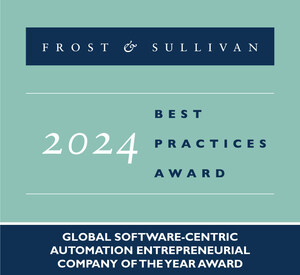Over 50% of Commercial Drone Flights Will Be Conducted Autonomously by 2022 Globally
Autonomous drones and hybrid propulsion innovations will drive new growth opportunities, finds Frost & Sullivan
SANTA CLARA, Calif., March 22, 2018 /PRNewswire/ -- The commercial unmanned aerial services (UAS) market is experiencing a steady economic expansion due to disruptive innovations such as autonomous platforms, transitional drones, and hybrid propulsion. Frost & Sullivan expects that by 2022 over 50 percent of commercial drone flights will be conducted autonomously operating much like warehouse robots operate today. This innovation will create new industry opportunities as drones will be used as a tool to make operations more efficient while drone maintenance and data security will become the prominent areas for revenue stream development. Demand for commercial drones in North America will generate the most revenues with Asia-Pacific a close second.
"The UAS market is becoming an ecosystem focused on information and value-added services where the drone is a tool acting as a cog in the big data machine," said Michael Blades, Aerospace, Defense, and Security Research Director, Frost & Sullivan. "Success in this ecosystem will be achieved by companies that can safely, quickly, and inexpensively provide high-grade data/information for real-time decision making."
Frost & Sullivan's recent analysis, Global Commercial UAS Market, Forecast to 2022, focuses on global hotspots, technologies, forecast and trends. Key findings, market engineering measurements, unit shipment, and revenue forecasts for segments such as, prosumer, consumer professional, industrial, enterprise, and FW/Transitional as well as regions like Africa, Asia-Pacific, Middle-East, North America, and South America are also provided.
For further information on this analysis, please visit: http://frost.ly/2c7
Blades expects mergers and acquisitions (M&A) activity within the industry to accelerate with several manufacturers forced out of the market. New original equipment manufacturers of higher-priced platforms will struggle to compete in an increasingly crowded market. DJI, the undisputed market leader in low-priced commercial platforms, has such a large share of the market that its ability to manipulate pricing will make it difficult for current and future competitors to gain market share.
Transformations that could disrupt and/or create new growth opportunities include:
- There will be a substantial decrease in the need and demand for remote pilots to operate drones on site;
- Regulatory frameworks, infrastructure, and public perception will be crucial for drone delivery to be a success in day-to-day logistics operations; and
- By 2022, the industry will look similar to the cell phone sector where there are a few hardware providers and a slew of open-source software and sensor providers that cater to specific applications.
"Global regulations generally do not allow beyond visual line of sight operations which severely restrains drone applications such as parcel delivery and long-distance monitoring," noted Blades. "If this was allowed it could generate considerable revenue streams."
Global Commercial UAS Market, Forecast to 2022 is part of Frost & Sullivan's global Aerospace and Defense Growth Partnership Service program.
About Frost & Sullivan
For over five decades, Frost & Sullivan has become world-renowned for its role in helping investors, corporate leaders and governments navigate economic changes and identify disruptive technologies, Mega Trends, new business models and companies to action, resulting in a continuous flow of growth opportunities to drive future success. Contact us: Start the discussion
Global Commercial UAS Market, Forecast to 2022
K21F_ 22
Contact:
Mariana Fernandez
Corporate Communications – North America
P: +1 (210) 348 1012
E: [email protected]
SOURCE Frost & Sullivan
Related Links
WANT YOUR COMPANY'S NEWS FEATURED ON PRNEWSWIRE.COM?
Newsrooms &
Influencers
Digital Media
Outlets
Journalists
Opted In





Share this article